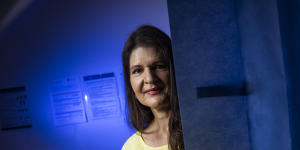A senior clinical psychologist and associate professor in the Department of Neuroscience at Monash University,Sharp has seven university degrees.
And yet,here she was “vulva shouting” on a Ted X talk.
It was a mistake to call the entire genital region the vagina,Sharp told the audience. The outside part is called the vulva. “Please repeat after me. Say ‘vulva’. And one last time with gusto:Vulva!”

Associate Professor Gemma Sharp is on a mission to teach girls,who are influenced by the Barbie “ideal”,that their vulvas are normal.Ben Searcy
Sharp is on a mission to teach girls their vulvas are normal.
Some girls are concerned their genitalia differs from the Barbie doll appearance,says Sharp,who became passionate about genital body image when researching the psychological predictors of labiaplasty (the surgical reduction of the inner lips of the vulva) for her PhD in clinical psychology.
Girls and women worry that protruding or uneven labia minora (the inner lips) are unsightly and abnormal,Sharp says,and they hear derogatory remarks about “meat curtains”.
“I thought – like a lot of people – why would people be getting surgery on a body part that lots of people don’t see?” Sharp says.
“At that stage,the numbers were increasing radically,so I was like,obviously,there’s some kind of trend going on here. What are the reasons that women are having these surgeries?”
for labiaplasty and vulvoplasty more than doubled from 707 in 2002-03 to 1584 in 2013-14. This was despite there being no increase in genital abnormalities.
A crackdown in 2014 means that Medicare can only be claimed now if the procedure is to repair female genital mutilation or correct an abnormality.
However,those who want genital cosmetic surgery can pay to have it done in the private sector,which does not require reporting of statistics.
Female genital cosmetic surgery can be performed by anyone with a medical degree,and no formal training is required.
Associate Professor Magdalena Simonis,author of the Royal Australian College of General Practitioners’,says while the number of procedures is not recorded in Australia,she has no doubt they are increasing.
“The incidence has not declined,it’s continued to steadily climb from the American stats and what you find online and in the chats,” Simonis says.
Young women are often concerned about how they look in bikinis or leisurewear.

Associate Professor Magdalena Simonis.Chris Hopkins
“There is a phrase that is used to describe what fleshy genital appearance looks like through clothing,and it’s camel toe. And there are all sorts of derogatory comments around that,” Simonis says.
“Forty to 50 per cent are dissatisfied with their bodies anyhow. So all you have to pick on is a particularly sensitive private area and focus the attention on that,and that becomes quite a significant concern for young people.”
What young women choosing to have labiaplasties often don’t realise,Simonis says,is that genital tissue shrinks as women go through menopause.
“Removing that tissue can have significant implications for sexual function and pleasure down the track.”
In 2015,Simonis was the lead author of a of 443 GPs. The research found 54 per cent of GPs had seen patients requesting female genital cosmetic surgery.
Of these,a third had received requests for labiaplasties from girls under 18.
“This did not even enter a lot of women’s minds as a mainstream cosmetic surgical issue and then all of a sudden,Brazilian waxing became really popular,and I think that’s really what uncovered what a lot of women didn’t know about themselves,” Simonis says.
Many GPs at the time of the study felt their knowledge was inadequate to deal with requests for female genital cosmetic surgery.
Simonis was commissioned to write for the Royal Australian College of General Practitioners,which recommend GPs educate patients about genital diversity,consider mental health and relationship abuse issues,and refer patients for a gynaecological assessment.
The Royal Australian and New Zealand College of Obstetricians and Gynaecologiststhere is no evidence that cosmetic vaginal procedures are effective,enhance sexual function or improve self-image.
It says the risks of potential complications such as scarring,permanent disfigurement and altered sexual sensations should be discussed in detail with women seeking such treatments.
In October 2016,the Medical Board of Australia advised that girls under 18 receive mandatory counselling and a three-month cooling-off period if they were seeking cosmetic vaginal procedures.
But Simonis believes this does not go far enough. She says Australia should match the UK Royal College of Obstetricians and Gynaecologists’ position that surgery be avoided under the age of 18.
“There’s just so much misinformation around the diversity of genital anatomy,and no one’s being taught about this.”
A Victorian Education Department spokesman says department resources support schools to provide students with sexuality education that includes realistic and age-appropriate diagrams of genitalia.
But Sharp says while the correct terms for female genitalia and the role of genitals in reproduction are often taught,young people concerned about how their genitals look are unlikely to have their concerns assuaged.
“I think if it’s taught in a body-image education program,then it has context for celebrating diversity rather than focusing solely on reproduction,” Sharp says.
She and her team at Monash University have developed an age-appropriate video to help promote a positive genital body image.
The video does not include any explicit images. It uses artistic representations of vulvas – such as cupcakes – and medical illustrations to show the diversity of genital appearance.

Cupcakes are used to illustrate the diversity of female genitalia in Associate Professor Gemma Sharp’s educational video on genital self-image.Elisabeth Palatiello
“No two vulvas look alike,” the video says. “Even though there is a great variety in how we can look down there,there’s usually only one type of genital appearance we see online,in social media,and even in our biology textbooks. It’s smooth,hairless and symmetrical and the labia minora are completely hidden. The funny thing is,this appearance is not common at all.”
Dr Justine O’Hara,a plastic surgeon who performs up to five labiaplasties a week,says for women whose labia cause pinching and infections and restrict their activities,the procedure has the potential to change the quality of their life.
However,she refuses to carry out labiaplasties on women who have normal genitalia but seek a Barbie anatomy,telling them the risk of surgery and potential for complications outweigh any benefits.
“My great concern is that if you shorten the labia,women are more likely to tear when they have babies and this is very difficult to repair,” O’Hara says.
She says young women often have an unrealistic idea of what female genitalia should look like due to exposure to pornography.
She refers them to the,a photo gallery of unaltered photos of women’s genitalia developed by Women’s Health Victoria,to show them the diversity of what is normal.
“I’ve had mothers bring young patients to appointments who are very anxious and I reassure them they are completely normal and nothing needs to be done,” O’Hara says.
University of Melbourne researcher Emma Barnard conducted a aimed at understanding why a growing number of young girls,some as young as 11,were seeking cosmetic surgery on their genitals.
The study followed a spike in girls and young women referred to the Royal Children’s Hospital in Melbourne because of concerns about how their labia looked – even though the hospital does not carry out cosmetic surgery.
Barnard interviewed 11 females who sought consultation with a health professional when aged 13-19,five of whom went on to have labiaplasty surgery.
“Unanimously,the participants recounted that when they sought consultation for genital appearance concerns and female genital cosmetic surgery,they did not know that a range of normal genital appearance existed,” Barnard wrote in an published in theJournal of Paediatrics and Child Health in 2023.
Kate* was 16 when she worried her labia didn’t look normal. “We didn’t know if[genital abnormality] was a thing because you know,my mum was different[to me].”
Isabelle*,who was 17 when she sought help from a medical professional,said her boyfriend started remarking on her physical appearance:“One day,there was a comment of hamburger flaps and it was something that his friends were saying as well.[Genital appearance concern] was still weighing heavily on my mind,so I started reading and researching and I started to see labiaplasties come up in general.”
Barnard asked participants if they had learned anything about genital diversity at school.
“A few participants did say I got sex education about reproduction and contraception and STIs but none of them,as far as I can recall,had any education around what genitals should look like,what is considered normal,that sort of thing.”

Associate Professor Gemma Sharp with some of the resources she uses to demonstrate the diversity of female genitalia.Jason South
In 2020,Sharp showed the vulva video to 343 girls aged 16-18,as part of a published in the journal,Body Image.
The video improved girls’ genital anatomy knowledge,and there was a small increase in satisfaction with their own genital appearance. There was also a small decrease in the likelihood of them considering labiaplasty in the future.
The study participants suggested younger girls could benefit from watching the video and that it be taught to all genders.
A of 125 parents – published inBody Journal this month – examined whether they would consent to their 13- to 15-year-old sons and daughters participating in genital body image education.
More than 80 per cent said they “definitely would” consent and no parents said that they “definitely would not” – a more ringing endorsement than Sharp expected.
“We hope in the future that body image education really does cover the whole body,” Sharp says.
*Not their real names
Make the most of your health,relationships,fitness and nutrition with our Live Well newsletter. every Monday.